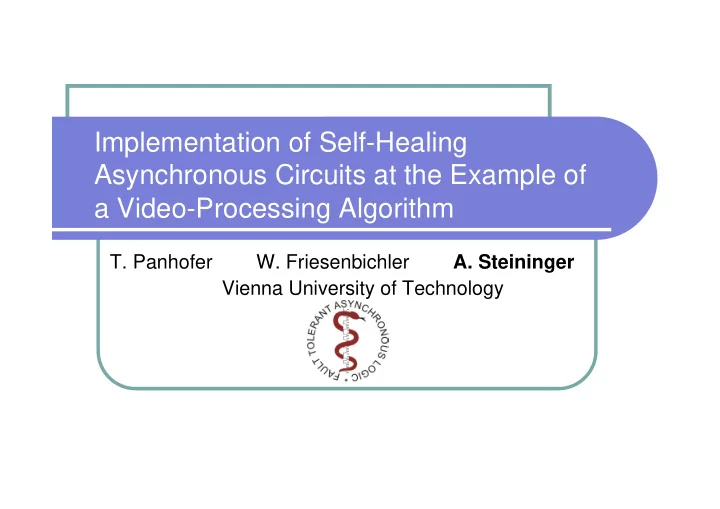

Implementation of Self-Healing Asynchronous Circuits at the Example of a Video-Processing Algorithm T. Panhofer W. Friesenbichler A. Steininger Vienna University of Technology
Outline � Motivation & Objective � Asynchronous Logic � Self-Healing Concept � Case Study: SH implementation of video processing algorithm � Experimental Results (& Lessons Learnt) � Conclusion & Outlook 2
The Nanoscale Challenges � significant parameter variations � threshold voltages, delays, leakages,… � increased rate of transient faults � lower voltage, smaller critical charge,… � increasing danger of permanent faults � more functions/chip, higher temperature � … 3
Resulting Needs � significant parameter variations need robust design methods that are inherently able to cope with these variations � increased rate of transient faults need fault tolerance or robustness � increasing danger of permanent faults need self-repair or „self-healing“ � … 4
Why Use Asynchronous Logic? � „delay insensitive“ operation � based on local handshaking (closed loop), � not on global clock (open loop) high robustness in time domain � two-rail coded data high robustness in value domain 5
FSL – How does it work? � dual-rail encoded data � two representations for HI/LO � tokens in alternating „phases“ implicit request explicit acknowledge 6
How far does this get us? � significant parameter variations delay-insensitive logic has a robust timing that can tolerate (virtually) all variations � increased rate of transient faults two-rail coding, robust timing � increasing danger of permanent faults still need self-repair or „self-healing“ 7
Requirements for „Self-Healing“ � detection of (permanent) error ☺ DI logic tends to stop working in this case � identification of faulty cell ☺ handshake signals tend to point there � fault removal ☺ temporal robustness makes re-routing easier 8
Self-Healing Concept (1) 9
Self-Healing Concept (2) Transformation Self-Healing Cell 10
What‘s the Benefit over TMR? � both approaches tolerate first fault � TMR without interruption of service (2oo3) � selfhealing possibly with interruption (1oo2) � self-healing is more fine-grained � more options to bypass defective element � no need to rely on „luck“ (next defect not in remaining operative nodes) 11
Why not use dynamic Reconfig.? � for FPGAs only � config interface = single point of failure � how derive new configuration? � static => too memory intensive need config for each defect set � dynamic => too performance intensive need PPR tool on mission 12
How control Reconfiguration? � Simple (=robust) solution: [initial idea] � „random repair“ without diagnosis � bits of a counter control switches � count up upon watchdog timeout => new configuration � if defect not removed => circuit still halted => next timeout => new try � with first valid configuration circuit operation continues 13
Application Study: GAIA VPU Part of the video processing algorithm used in the ESA space mission GAIA GAIA VPU = GAIA Video Processing Unit linear correction dead column correction 14
Why use this Application? � real-world circuit structure and size � pipeline with forks, joins and loops � typical space application � long mission time � extreme environment � high dependabiltiy required � no manual repair possible => self-healing is attractive 15
Environment for HW-Experiments …embedded into the fault injection environment STEFAN = Synthesizeable Test Environment For Asynchronous Networks 16
HW Experiments – Results � Autonomous reconfiguration � Single stuck-at fault injected at internal acknowledge signal � Counter used as reconfiguration controller 17
HW Experiments – Resources � # of 4-input LUTs (Xilinx Virtex-4) � Standard FPGAs can be used for prototyping of asynchronous logic, but are not efficient � 207% resources but multiple fault tolerance � Reconfiguration Unit might have significant impact 18
Lessons Learnt � In principle the idea works, BUT � reconfiguration controller problematic � counter causes overhead => use LFSR � too many values to try => split controllers � ineffective repair attempts may corrupt state => need diagnosis and systematic repair � better solution: � block-wise diagnosis � with local „random“ repair 19
Conclusion � asynchronous logic can solve some of the problems associated with nanoscale � permanent faults require self-repair, asynchronous design aids in � detection � reconfiguration and � recovery � fine-grain repair beneficial over component-level repair � presented solution shown to work in 20 principle but reconfiguration controller
Thank you for your attention!
Environment for Experiments Self-Healing implementation… 22
SHC Reliability vs. Overhead Example: fine/coarse granular SHC adder coarse grain: constant overhead fine grain: decreasing relative overhead of switches 23
Recommend
More recommend